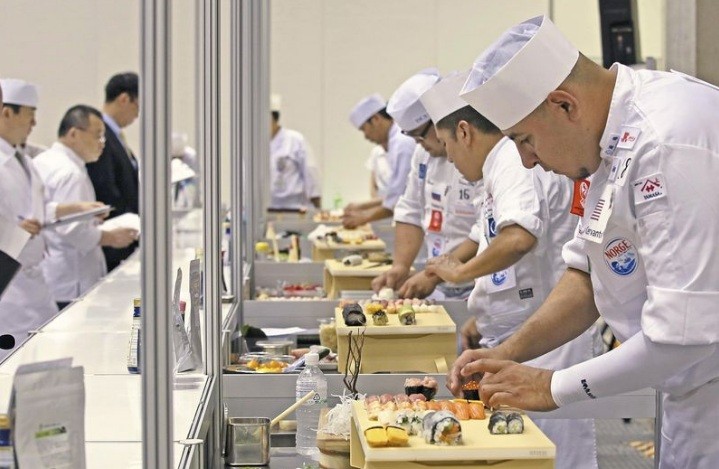Popular Reads
Top Results
Can't find what you're looking for?
View all search resultsPopular Reads
Top Results
Can't find what you're looking for?
View all search resultsChefs from around globe vie for Sushi Cup
Change text size
Gift Premium Articles
to Anyone
W
hile athletes from around the world were competing at the Rio de Janeiro Olympics last month, Tokyo hosted another global competition — for chefs of one of Japan’s most iconic dishes: sushi.
Held at Tokyo Big Sight in Koto Ward, this year’s World Sushi Cup featured 27 participants from 15 countries and territories, including France, Malaysia, Norway, Russia, Spain and the United States.
The two-day annual event started with the preliminary Edomae (Edo-style) Sushi Open Competition in which contestants were required to prepare such ingredients as akagai (ark shell), kohada (Japanese shad) and anago (conger eel) within 30 minutes. They then had to make 30 to 40 pieces of traditional sushi within 40 minutes.
The top 20 qualified for the final, the Creative Sushi Open Competition, held the following day. They were required to make sushi in their own styles within 40 minutes.
The contest is open to chefs with at least five years’ experience making sushi and who are not Japanese, among other criteria.
The World Sushi Cup, organized by the Agriculture, Forestry and Fisheries Ministry, was launched in 2013 to promote proper Japanese food culture and improve sanitation regarding raw food.
(Read also: For sushi lovers: Five interesting facts you should know)
The work of the contestants was evaluated by nine judges, including executive members from the All Japan Sushi Association and the World Sushi Skills Institute. They based their judgments on 37 criteria over the two days, including apparel and efficiency.
On the second day of the competition, the degree to which the finalists creatively combined sushi with their own cultures was evaluated. The participant with the highest score over the two competitions won the title.
This year’s title went to Celso Hideji Amano from Sao Paulo, a 38-year-old descendant of Japanese emigrants to Brazil. He has worked as a sushi chef for 16 years.
“I came to Japan a month ago to prepare for the event,” Amano said in tears. “I thank all the people who have supported me.”
Washoku cuisine is registered on UNESCO’s Intangible Cultural Heritage list. According to organizers of the World Sushi Cup, there are about 50,000 sushi restaurants overseas, of which 40,000 serve dishes made by chefs without proper food preparation knowledge and skills in accordance with Japanese standards.
“Through this World Cup, we hope to create international standards for sushi making and hygiene,” said Masayoshi Kazato, who chaired the competition. “We also hope the participants will work as goodwill ambassadors to promote authentic sushi as part of Japanese culture.”











